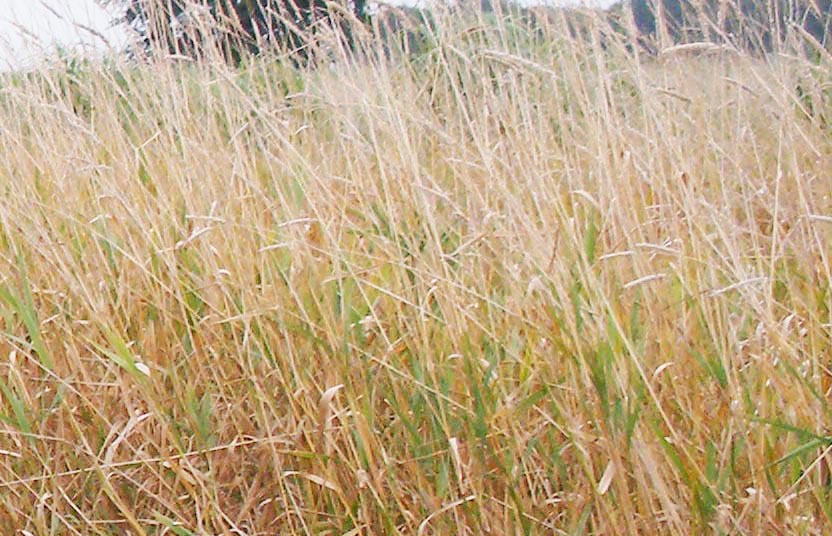Analysis of Switchgrass

Background
Switchgrass (Panicum virgatum L.) is an American C4 grass that is established from seeds, an advantage over Miscanthus which has to be propagated. The temperature for germination varies with clonal variety; from 5.5 to 10.9 degrees Celsius. The crop should be sown in May or June, flowering will probably occur in the late summer, and senescence in the autumn.Switchgrass does well on a wide variety of soil types. It is drought tolerant and grows well on shallow rocky soils. It is also tolerant to wet areas. It can grow on sand to clay loam soils and tolerates soils with pH values ranging from 4.9 to 7.6.
There are various reports that switchgrass shows no response to N fertilizer or only to the first 50 kg. In fertile sites switchgrass may require little or no fertilisation, and, generally, will require less fertilisation than Miscanthus. Weeds, however, can be a major problem in establishment, and it is important that these are controlled in the first year, and totally removed before establishment. Insects can also decrease the effectiveness of establishment and result in a longer period needed before ceiling yields are obtained. There are also diseases that may decrease yields, for example the Panicum mosaic virus, or various leaf rusts (Puccinia spp.).
As with reed canary grass, conventional hay harvesting equipment can be used to harvest switchgrass. The crop usually needs to be harvested after senescence to prevent lodging losses, although such losses tend to be less than with reed canary grass. The effects of a delayed harvest on yields and chemical composition are likely to be less than those for Miscanthus, given that Switchgrass does not shed its leaves to the extent that Miscanthus x giganteus does.
While the crop can be harvested twice a year, a single harvest tends to give higher yields in temperate climates and will be more economic. Switchgrass yields generally increase yearly for the first three years before levelling-off in most varieties.
Analysis of Switchgrass at Celignis
Celignis Analytical can determine the following properties of Switchgrass samples:
Sugars (Monosaccharides)
Sugar Alcohols and Uronic Acids
Lignin and Extractives
- Lignin (Klason)
- Lignin (Klason - Protein Corrected)
- Lignin (Acid Soluble)
- Acid Insoluble Residue
- Extractives (Ethanol-Soluble)
- Extractives (Water-Soluble)
- Extractives (Exhaustive - Water then Ethanol)
- Lignin S/G Ratio
- Extractives (Water-Insoluble, Ethanol Soluble)
- Protein Content of Acid Insoluble Residue
- Carbon Content of Acid Insoluble Residue
- Hydrogen Content of Acid Insoluble Residue
- Nitrogen Content of Acid Insoluble Residue
- Sulphur Content of Acid Insoluble Residue
Amino
Acids
Thermal Properties
- Moisture
- Ash
- Ash (Acid Insoluble)
- Carbon
- Hydrogen
- Nitrogen
- Sulphur
- Oxygen
- Volatile Matter
- Fixed Carbon
- Gross Calorific Value
- Net Calorific Value
- Chlorine
- Ash Shrinkage Starting Temperature (Oxidising)
- Ash Deformation Temperature (Oxidising)
- Ash Hemisphere Temperature (Oxidising)
- Ash Flow Temperature (Oxidising)
- Ash Shrinkage Starting Temperature (Reducing)
- Ash Deformation Temperature (Reducing)
- Ash Hemisphere Temperature (Reducing)
- Ash Flow Temperature (Reducing)
- Thernogram - Under Nitrogen
- Thermogram - Under Air
Major and Minor Elements
Cellulose Content of Switchgrass
Switchgrass tends to have a similar composition to Miscanthus, with cellulose being the main mass constituent. The cellulose content will be dependent on the productivity of the crop; shorter plants tend to have lower cellulose contents than taller, more productive, plantsClick here to see the Celignis Analysis Packages that determine cellulose content.
Hemicellulose Content of Switchgrass
As with Miscanthus, arabinoxylan is the main hemicellulose in switchgrass with xylose the most abundant hemicellulosic sugar.Click here to see the Celignis Analysis Packages that determine hemicellulose content.
Lignin Content of Switchgrass
The lignin content of switchgrass will depend on what particular clonal variety is being grown as well as on the productivity of the crop. Smaller plants tend to have a greater leaf:stem mass ratio than taller plants and this means that the lignin and cellulose contents are typically lower whilst the extractives and ash contents are higher.Click here to see the Celignis Analysis Packages that determine lignin content.
Starch Content of Switchgrass
The starch content of switchgrass varies between the different anatomical components of the plant. Typically it is highest in the leaves, where photosynthesis takes place, and lower in the stems. The starch content can also vary according to the maturity of the plant.Click here to see the Celignis Analysis Packages that determine starch content.
Uronic Acid Content of Switchgrass
Uronic acids are present in the hemicelluloses in switchgrass and are typically more abundant in the early-stages of growth. Furthermore, the concentrations of uronic acids tends to be greatest in the nodes, lower in the internodes, and at intermediate levels in the leaves.Click here to read more about uronic acids and to see the Celignis Analysis Packages that determine uronic acid content.
Enzymatic Hydrolysis of Switchgrass
We can undertake tests involving the enzymatic hydrolysis of Switchgrass. In these experiments we can either use a commercial enzyme mix or you can supply your own enzymes.We also offer analysis packages that compare the enzymatic hydrolysis of a pre-treated sample with that of the native original material.
Click here to read more about enzymatic hydrolysis and to see the various analysis packages that we offer.
Ash Content of Switchgrass
The ash content of switchgrass will vary according to the clonal variety and plant productivity.Click here to see the Celignis Analysis Packages that determine ash content.
Heating (Calorific) Value of Switchgrass
Switchgrass can have an attractive heating value, however the effective heating value will depend on the moisture content of the crop.Click here to see the Celignis Analysis Packages that determine heating value.
Bulk Density of Switchgrass
At Celignis we can determine the bulk density of biomass samples, including Switchgrass, according to ISO standard 17828 (2015). This method requires the biomass to be in an appropriate form (chips or powder) for density determination.Click here to see the Celignis Analysis Packages that determine bulk density.
Basic Density of Switchgrass
At Celignis we can determine the basic density of some suitable biomass samples. The method requires the biomass to be in an appropriate form (chips) for density determination.Click here to see the Celignis Analysis Packages that determine basic density.
| Previous Feedstock | Next Feedstock |
Go Back to List of Feedstocks.
Energy
Crops
Agricultural Residues and Wastes
Industrial Residues and Wastes
Municipal
Wastes
Biorefinery
Products






